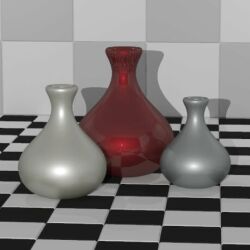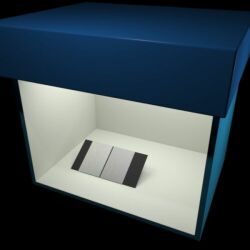 |
Computer Graphic Rendering of Material Surfaces |
 |
 |
Computer Graphic Rendering of Material Surfaces |
 |
Discussion of Rendering
In order to realize the overall purposes of the project, we set the goal of producing visually and radiometrically accurate renderings of selected aspects of the appearance of complex surfaces; seeking to provide a proven path from material measurement and characterization to object rendering. At this point, it would be helpful to answer the question, just what is rendering? It is the process of producing a synthetic image using a computer. To do this certain input parameters are required. If the scene is a conference room for example, a geometric description of the objects in the room; furniture, light sources, carpeting, windows, etc. must be provided. Secondly,there needs to be a description of the light sources, their location and radiometric properties. Thirdly the light scattering properties of an object in the room must be described-thus we must have the BRDF of the object (or BRTDF if light is also transmitted). Finally an observation viewpoint must be specified that defines the plane from which the image will be viewed. These parameters are used in an integral equation which describes the relationship between the amount of light incident to a surface in every direction and at a given point and the amount of light reflected or emitted from the surface in a given direction at that point:
where
is the BRDF of a surface at the incident direction
and reflected direction
and
is the wavelength of the incident light which we assume remains the same when reflected.
, is the radiance of incoming light at (x, y, z) travelling in the direction given by
.
is similarly defined for light in an outgoing direction from (x, y, z). The units of radiance are
where sr-steradians are solid angle units. The radiance of light incident at a point (x, y, z) can be related to the outgoing radiance at the same point so that the integral equation can be written as an equation for a single unknown radiance function L. A large part of the work done by the rendering program is the computation of a numerical solution of this equation, providing the radiance for each point in the scene that is visible to the observer or detector. A visual representation of the solution in a geometric description of the scene is the basis for the synthetic image. For more information on computer image synthesis see Glassner [GLASS95].
|
Privacy Statement/Security Notice | Disclaimer | FOIA NIST is an agency of the U.S. Commerce Department's Technology Administration. |